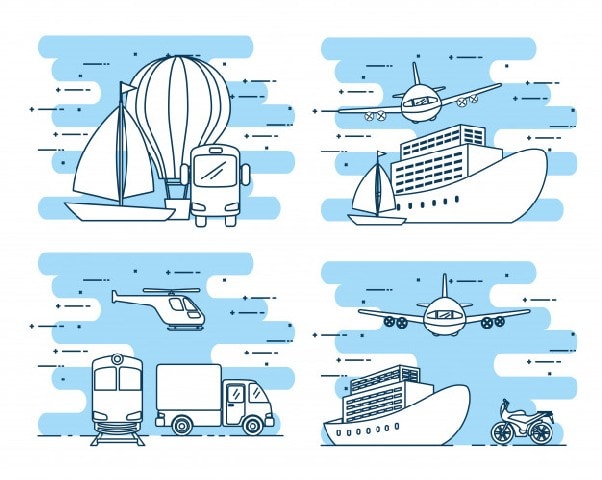Transportation planning is defined as a process for moving goods and human beings and sometimes even animals to their destination. It is referred to as a collaborative process of identifying future designs, goals, and policies of transport facilities.
Table of Contents
Meaning of transportation planning
The transportation planning process takes the help of the input offered by government agencies and private and public businesses to analyze the various alternatives and also their impact on the transportation system so that the outcome can prove beneficial for all the stakeholders including common masses.
Transportation planning is involved with designing, assessment, and evaluation of various transport facilities like public transport lines, bike lanes, highways, and streets. Increased usage of research in recent years seeks to optimize the system performance for achieving more significant advantages from the facilities.
Understanding transportation planning
Transportation planning is a necessity because it assists in achieving an economical, convenient, faster, secure and safer movement of people, animals, and goods. It is also essential in promoting interaction within a community, sustainable development, safe accessibility, gaining access to economic activities and shaping cities by enhancing the quality of life.
Under the transportation planning g program, several practices come together. These are
- Legislative activities
- Funding bodies
- Urban transport policies
- Urban development
- Project management
The transportation planning involves that several organizations and agencies come together so that a successful plan can be created. It is the governing bodies that look at the travel patterns and demographic characteristics of a specific area and make notations about how it changes over a particular time. It is then these governing bodies that suggest alternative improvements after a lot of evaluation and deliberations.
The need for transportation planning
The need for effective transportation planning is because of the following reasons –
- Understand the current transportation system
- Review the existing transportation planning
- Identifying problems and issues in the transportation system
- Finding solutions and considering potential changes that can bring improvement in the current plan and also for the future
- Assess the numerous operational and transport choices
- Finding out the multiple options for transporting goods and people
- Recalling the actual purpose of the transportation planning
- Optimization of the current transport system and its structural design
Importance of transportation planning
It is essential to address the various transportation planning challenges to create a better plan for the future. Some of them are as follows-
1. Minimizing the impact on climate change
It is a hard fact to face that pollution has increased because of transportation emission. It is the need of the hour to enhance technology so that it can result in cleaner fuels. It should be the priority of people who are involved in transportation planning to upgrade the infrastructure so that people can choose less polluting methods of transportation.
2. Good choices
Proper transportation planning should be inclusive of all the travel modes so that it becomes easier for people to make choices that are good for their health
3. Air quality
The importance of a transportation planning process is that if advanced technology is used creatively, then it will improve the air quality and reduce air pollution
Objectives of transportation planning
The transportation planning committee has to take into account various stakeholders and their objectives before making an effective plan. The stakeholders and their objectives have been described below-
1. The government’s objectives –
The government’s objectives ensure that all the areas where it can have an impact are considered before making a viable plan. The transportation planning objectives in relevance with the government are
- Safety
- Improving security
- Reduce accidents
- Environment
- Reducing the levels of noise
- Minimizing greenhouse gases
- Improving the quality of air
- Improving the ambiance during the journey
- Enhancing the landscape
- Economy
- Improving transport economic efficiency for transport providers and business users
- Social inclusion
- Access to facilities
- Integration
- Integration between different modes of transport
- Integrate transportation policy with other government policies
2. National transport strategy
- Promote economic growth by enhancing the transport system and infrastructure
- Connect remote communities by increasing accessibility to the transport network
- Protect the environment by investing in sustainable transport which will minimize emissions
- Improve safety in journeys
- Promote public safety
- Conserve and enhance the environment through sustainable development
- Facilitate easy access to hospitals and other places where health service is provided
- Enhance economic and social well-being
- Make the best use of the existing transport system for all users
- Improve safety
Process of transportation planning
The transportation planning process is very complex and involves–
- Cataloging the existing conditions
- Making forecasts for land use and future conditions
- Evaluating all the alternative plans based on cost-benefit analysis
- Adoption of a viable plan
- Implementing the said plan
- Continuous and regular study to understand and assess the impact of the plan so that it will prove useful in future planning
The following stages have great relevance in the transportation planning process. These are
1. Trip generation –
A trip is defined as a movement of an individual from an origin to the destination point through a mechanized transport mode. It can be from his home to another place, for instance to his office or from market to home or another place. Trips are referred to as home-based when either the point of origin or destination is the home or non-home-based where neither end of the trip is the home.
The trip ends are also referred to as attractions or generations. When you are referring to non- home-based trip, the origin of the trip is referred to as generation and destination as attraction and in the case of a home-based trip, the home-end of the trip is referred to as generation and the non-home end as an attraction. Several factors govern the trip attraction and generation and these are described below
- Family income – It is a fact of life that more the income, higher will be the rate of trip generation
- Family size and composition – Age structure also is a significant determinant for trip generations. If you have young school and college-going children at home, it will generate more trips. Similarly, if you have more earning members in the family especially those who go out to work, then it will generate a greater number of trips. It is a fact of life that older people generate less number of trips than youngsters or young adults
- If a person has access to the easy public transport system, then it will generate more trips
- Car ownership – If a household owns a car then the chances of trip generation is more compared with those who do not have a vehicle of their own
- Land-use – Land-use have a direct impact on the trip generation
- Numerous opportunities for employment can generate more trips
- Existence of shopping complexes as well as other entertaining and recreational grounds have a greater and positive impact on the trip generation
Two approaches are used for estimating trip generation, and these are
- Multiple Linear Regression analysis – It is a statistical technique that uses the mathematical relationship to connect a dependent variable with an independent one. In this scenario, the dependent variable includes the total number of trips and the independent variable are the measurable factors that influence the trip generation
- Category Analysis – This technique of estimating trip generation takes into account trips by individual households. This scenario considers car-ownership levels, income-class, etc. as variables. An important benefit of using Category analysis is that as there are no mathematical equations involved the computation seems very simple
3. Trip purpose
An individual will make trips for different reasons, and it makes it easy if the purpose can be classified. Some important ones are
- Business
- Education
- Work
- Sports
- Medical and health
- Recreational
- Social
- Shopping
- Miscellaneous purposes
3. Trip distribution
The trip distribution estimates the movement between origin and the destination. It now tries to apportion the trips to specific zones to which they are attracted. This stage of trip distribution in transportation planning as its name suggests the number of trips that takes place between two specific zones of origin and destination.
Two methods are generally used for determining trip distribution. These are
- Synthetic Method – Existing data is used in the synthetic method for
- Developing a relationship between trips
- The attractiveness of the travel zones
- Resistance to travel between the travel zones
The synthetic model can be used to make predictions about the pattern of future travel trips in terms of inter-zonal trips.
Growth Factor Method
The growth factor method is considered very simple and is generally used for smaller areas. In this method, it is assumed that the existing travel patterns can be displayed to a future design year by using certain growth factors.
4. Traffic assignment
In this stage of transportation planning, the trip interchanges are apportioned to different routes. This is done by predetermining the path between any two pairs and assigning inter-zonal flow of trip to the selected way.
The traffic assignment is based on route selection which in itself is dependent on safety, convenience, comfort, cost, distance and time. For small jobs, manually, route selection can be considered but for large jobs, it is necessary to use a digital computer. The various traffic assignment methods that are used are
- Diversion curves approach
- Capacity restraint method
- Multiple route method
- All-or-nothing method
5. Mode split
This stage of transportation planning includes separating the trips with the help of travel modes. It includes trips made by both public transportation system and private cars. Some factors affecting it are
- Distance and purpose of the trip
- Characteristics related to zones like the concentration of workers, residential density and distance from the central district
- Features related to the household like composition, family size, car ownership and income
- Travel time and accessibility comparison by various travel modes
Advantages of transportation planning
The advantages of a good transportation planning process are as follows-
- Transportation planning can identify the existing deficiencies in the system and make viable changes to address the issues for the future
- An efficient transportation planning minimizes the chances of accidents and mishaps on the route
- It provides alternative strategies to solve transportation problems
- A completed transportation planning process communicates the desire and direction of the state for progress.
- A proper transportation planning process assists in shaping the economic quality of life because it can enhance the mobility of goods and people.
- It offers access to land and influences the pattern of economic activity and growth in an area
- Effective transportation planning brings about an overall improvement in an area
- Transportation planning is beneficial because it ensures that any hazardous conditions are updated at regular intervals
- A useful transportation planning has to improve the comfort and safety of people and even animals
Did you know that effective transportation planning can significantly improve urban living?
According to the International Transport Forum, improving public transportation infrastructure can reduce urban car traffic by up to 60%. This reduction not only eases congestion but also significantly lowers greenhouse gas emissions, contributing to urban sustainability. Additionally, cities like Copenhagen have showcased the success of integrated bike lanes, which increased cycling by 30% between 2010 and 2020, proving that well-planned transportation systems can encourage environmentally friendly travel modes.
When pursuing efficient transportation planning, consider adopting tools like the Urban Mobility Observatory (UMO) and the OpenTripPlanner. These tools provide valuable insights into travel behavior and public transport efficiency, helping planners optimize routes and improve accessibility. The OpenTripPlanner, for example, is an open-source software suite that supports transit trip planning and is employed by cities worldwide to enhance urban transit systems.
Liked this post? Check out the complete series on Distribution




